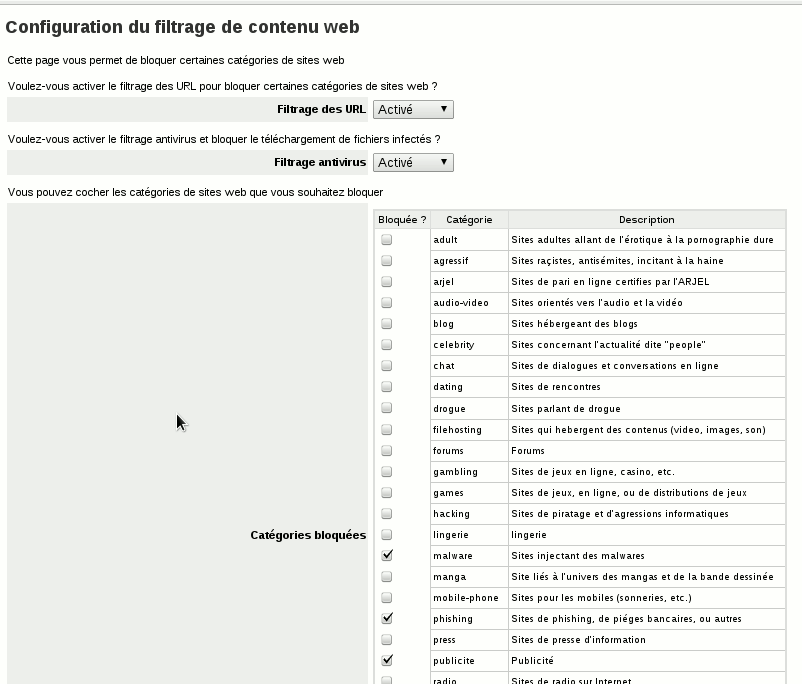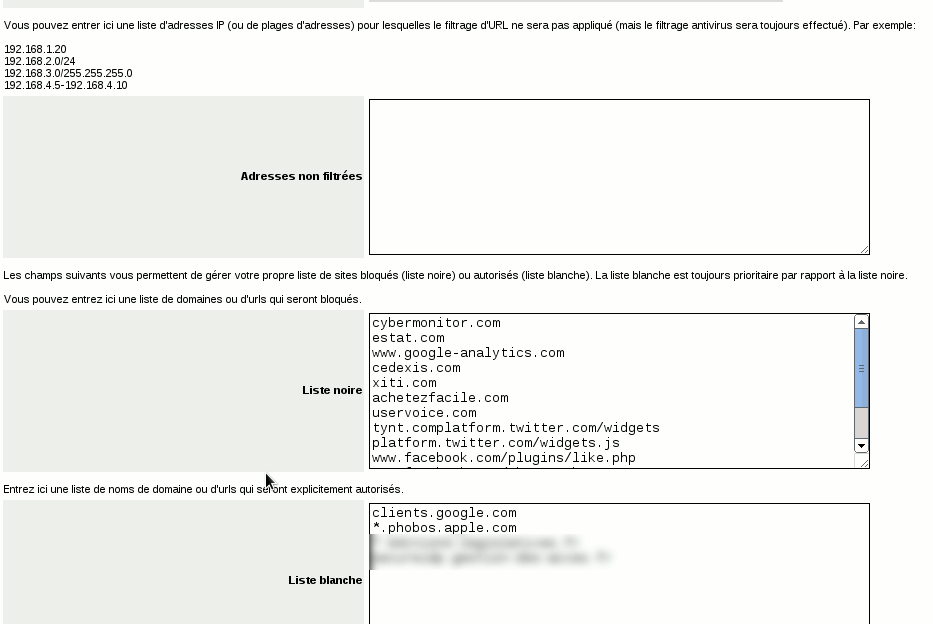Difference between revisions of "WebFilter"
m (→Installation) |
m (→Description) |
||
| Line 11: | Line 11: | ||
This contrib brings 3 new features for squid proxy, and provides a simple panel to control most of it: | This contrib brings 3 new features for squid proxy, and provides a simple panel to control most of it: | ||
*URL Filtering (with [http://squidguard.org/ squidGuard]) | *URL Filtering (with [http://squidguard.org/ squidGuard]) | ||
| − | Several categories of domain names and URLs are downloaded from the University of Toulouse and updated every night (you can get more informations on these lists [http://dsi.ut-capitole.fr/blacklists/ here), | + | Several categories of domain names and URLs are downloaded from the University of Toulouse and updated every night (you can get more informations on these lists [http://dsi.ut-capitole.fr/blacklists/ here]), in french). You can then just choose which catagories you want to block. You can enter a list of ip addresses which won't be filtered, and a local blacklist and whitelist. |
*On the fly antivirus scanning (using ([http://squidclamav.darold.net/ squidclamav]) | *On the fly antivirus scanning (using ([http://squidclamav.darold.net/ squidclamav]) | ||
When enabled, all web trafic will be scanned before being sent to the client | When enabled, all web trafic will be scanned before being sent to the client | ||
| Line 17: | Line 17: | ||
Every request passing through squid is logged in a database, making it easier to analyze squid logs. There's no frontend for this, but you can use your favorite mysql client to see which domains are the most visited, which user eats all your bandwidth, etc... | Every request passing through squid is logged in a database, making it easier to analyze squid logs. There's no frontend for this, but you can use your favorite mysql client to see which domains are the most visited, which user eats all your bandwidth, etc... | ||
| − | This contrib can replace dansguardian if you have simple filtering | + | This contrib can replace dansguardian if you have simple filtering requirements. It's really easy to configure, but is also less powerfull. Dansguardian is a real content scanner (it analyze the content of the pages while squidguard only look at the URLs for example). |
===Requirements=== | ===Requirements=== | ||
Revision as of 22:31, 15 October 2012
Maintainer
Daniel B.
Firewall Services
mailto:daniel@firewall-services.com
Description
This contrib brings 3 new features for squid proxy, and provides a simple panel to control most of it:
- URL Filtering (with squidGuard)
Several categories of domain names and URLs are downloaded from the University of Toulouse and updated every night (you can get more informations on these lists here), in french). You can then just choose which catagories you want to block. You can enter a list of ip addresses which won't be filtered, and a local blacklist and whitelist.
- On the fly antivirus scanning (using (squidclamav)
When enabled, all web trafic will be scanned before being sent to the client
- log every requests in a MySQL database
Every request passing through squid is logged in a database, making it easier to analyze squid logs. There's no frontend for this, but you can use your favorite mysql client to see which domains are the most visited, which user eats all your bandwidth, etc...
This contrib can replace dansguardian if you have simple filtering requirements. It's really easy to configure, but is also less powerfull. Dansguardian is a real content scanner (it analyze the content of the pages while squidguard only look at the URLs for example).
Requirements
- SME Server 8 (not tested and not supported on SME 7)
- You need to configure both Epel and Fws repositories
Screenshots
Installation
To install the contrib, simply run the following command:
yum --enablerepo=epel --enablerepo=fws install smeserver-webfilter signal-event http-proxy-update expand-template /etc/httpd/conf/httpd.conf sv t /service/httpd-e-smith
You can then access the new panel in the server-manager. The first time you access it, you might have an empty category list. Just click the save button at the bottom of the page, wait a few minutes and try again (the list is empty because categories hasn't been downloaded yet). Now, you should be able to enable URL and AV filtering, and choose which categories you want to block. The next settings modification might take a long time (several minutes, you may also have a imeout error displayed). This is expected and id because squidGuard database needs to be compiled. After this, settings change should be fast.
Customize category lists
Category lists are simple text files in /var/lib/squidGuard/blacklists. Each category is a directory, adn each directory may have a file names domains and another named urls. Each directory in /var/lib/squidGuard/blacklists will be displayed in the panel of the server-manager, except if it's listed in the DisabledCategories prop. You can see which categories are disabled with:
db configuration getprop squidguard DisabledCategories
This lets you ignore some useless category, and make the panel for simple. The default config update all the categories each night. This is done in the cron job /etc/cron.daily/squidGuard, which calls /etc/e-smith/events/actions/squidguard-update-databases. If you don't want to auto update those lists, you can disable this feature: db configuration setprop squidguard AutoUpdate disabled Then, you'll be able to manage the list the way you want. Remember you need to recompile squidGuard databases if you modify files in a list.
MySQL logs
MySQL loging of clients requests is handled by a independant daemon called squid-db-logd. It monitors squid access log and squidGuard deny log in realtime, parse it and put everything in the database called squid_log. In this database, the table access_log list all the access while the deny_log only list denied pages. This feature may need a lot of space. On a busy server, you can easily reach 3GB / month only for the database (and more for the dump when you backup your server). To lmit the needed space, a cron job rotate and compress the access_log and deny_log tables each month. Old tables are also removed. The default config keeps one year of log. You can change this setting with (value is in day and default is 365)
db configuration setprop squid-db-logd Retention 180
If you want to completly disable this feature, you can stop this daemon:
db configuration setprop squid-db-logd status disabled sv d /service/squid-db-logd
Here are some example of queries you can run:
- Get the top 30 most visited domains
echo "SELECT DOMAIN,COUNT(DOMAIN) AS occurances FROM access_log GROUP BY DOMAIN ORDER BY occurances DESC LIMIT 30;" | mysql squid_log
- Get the top 10 most used blocked categories
echo "SELECT category,COUNT(category) AS occurances FROM deny_log GROUP BY category ORDER BY occurances DESC LIMIT 10;" | mysql squid_log
- get all the pages requested by the client 192.168.7.50 on Oct 12 2012 between 10pm and 11 pm, and export the result in /tmp/result.csv
echo SELECT date_day,date_time,url,username INTO OUTFILE '/tmp/result.csv' FIELDS TERMINATED BY ',' OPTIONALLY ENCLOSED BY '"' ESCAPED BY '\\' LINES TERMINATED BY '\n' FROM access_log WHERE client_ip='192.168.7.50' AND date_day='2012-10-08' AND date_time>'22:00:00' AND date_time<'23:00:00';" mysql squid_log

